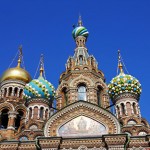Taj Mahal – Love at First Sight (15.09.14)
Without doubt, the Taj Mahal in Agra is my favourite building in the world.

Commissioned by Shah Jahan in 1631, it is a mausoleum to his wife Mumtaz Mahal who died giving birth to their 14th child. Brushing aside the phenomenal statistics behind its creation, construction and completion, the raw stunning beauty of this most famous of Mughal architectural wonders never ceases to take me by surprise.
Although I have genuinely lost count of the number of times I have visited (over twenty), every time I go, it feels as if I am seeing it for the first time. I am always bowled over by its size, brilliant white brightness and immaculate inlaid stone craftsmanship. It simply stops you dead in your tracks time and time again.
Whenever possible we at Nomadic Thoughts try to arrange a client’s itinerary to include this poignant 17th century UNESCO World Heritage Site. I believe it is impossible to over-hype the Taj, rightly regarded as one of the Seven Wonders of the World.
The first time I visited was aged six in 1968, when my family lived in southern India. Even then, before stepping through the main entrance gates I remember my mother holding me by the shoulders saying ‘You have to remember this day for the rest of your life. This is the most beautiful building in the world … you HAVE to remember this day’.

Main Gate
Well, the good news is I still do remember my first Taj Mahal visit. I can also distinctly remember how excited they were when we were told we would be going back to re-visit it in full moonlight. Although I do clearly recollect my parents’ excitement and their ‘must remember’ insistence, I personally could not see the fuss over the moonlight visit. As far as I was concerned, it appeared just as big and bright under the moonlight, as it did under daylight.
Although the Taj Mahal itself has not changed much in the ensuing forty-five plus years, the environment and surrounding area have changed considerably. These changes highlight the importance of preservation and protection issues.
For example, the expansion in local industry, traffic and population has had a dramatic effect on the Taj’s white marble colour, with sulphur dioxide and nitrous oxide gases turning it, in places, a shade of yellow. In addition, located as it is on the banks of the Yamuna River – downstream from Delhi – it reportedly suffers from waters highly contaminated by chemicals and sewage. This raises real concerns that the wooden foundations could be disastrously affected.

Taj Mausoleum doorway
The explosion in the local population is not the only factor affecting the locality of the Taj Mahal; there also has been a tenfold rise in visitors over the past few decades. The good news is that while the authorities continue to be sensitive to visitor demand, they are also trying to minimise visitor impact. This is a struggle considering that over 20,000 people (the same number it took to originally build the Taj Mahal over a 22 year period) now visit on a daily basis.
All this is a far cry from when I was a young traveller in the early 1980s too. Then, one could visit the Taj as frequently as one felt the urge, with a 2 rupee (5p) entrance fee and a pretty much run-of-the-house feel, once inside. I remember spending whole days lying around the gardens chatting to whoever else was there, as the heat of the day gave way to spectacular sunsets and more often than not, magical fire-fly light shows at night. Equally, sneaking through the entrances before dawn or after sundown one could soak up, on a daily basis, the most spectacular of sights as the whole enormity of the Taj Mahal changed colour with the surrounding daylight or moonlight.

These photos, all taken during my last visit with my family less than two years ago, offer an insight into the scale of this extraordinary mausoleum. The sheer beauty of the building remains as humbling and thrilling today as it ever was. I can also assure you that once you start exploring it with a knowledgeable guide, you soon understand why it took more than 1,000 elephants to carry in the construction materials – as well as 28 different types of precious and semi-precious stones (jade, lapis lazuli, turquoise, amethyst, to mention but a few).
You may or may not agree that it is the most beautiful building in the world, but I can guarantee that the Taj Mahal will have a profound impact on you when you first set eyes on it. Oh … and don’t forget the sunglasses.
Photos in order of approach:

Approaching the Main Gate

First glimpse of Taj, and Nicki, at Main Gate.


Taj Mahal security


Side Mosque

Time out at the Taj

View back to Main Gate from Taj







